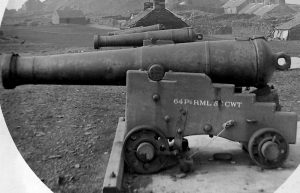Today we are guests of the Easdale Volunteers. It’s 14 July 1899 and we are standing on the summit of Easdale Island. Shortly we will watch them fire artillery shells out to sea. We can re-enact their training exercise because a report has survived, which records everything in the smallest detail.
One hundred and twenty-two men are on duty. Below us, to the left, on a grassy area by the beach, four 64-pounder artillery guns point out to the Atlantic. Detachments of eight men stand beside them. Elsewhere other men are preparing the ammunition. Here on the summit, in front of us, Captain Patrick Gillies is in position, peering at a tiny target floating in the distance. Men had taken a boat out to sea for more than a mile, towing a raft with a wooden cask and a red flag. Where the ocean shallows, they had anchored it to the sea floor.
The training begins. Captain Gillies estimates the range to the target and shouts his orders to the guns below, listening carefully as Sergeant Orr repeats them back to prove he has heard them correctly. Sergeant McLucas commands the first gun: the sights are set to two thousand one hundred yards; a silk cartridge bag with eight pounds of gunpowder is pushed into the barrel, followed by a sixty-four pound shell, its safety pin removed. He checks the aim is precise. The gun fires.
Patrick Gillies counts six seconds and watches the shell burst short of the target. If he orders a bold increase in range, so that the next shell lands beyond the target, it will be simple enough to halve subsequent corrections until the exact range is found. But Patrick is not bold enough. Everyone watches as the second shell also drops short, wasting time, wasting ammunition. He won’t make the same mistake again.
He finds the correct range with four more shells. All four guns now fire, and shells burst around the target. If this were an enemy gunboat instead of a wooden cask, it would be badly damaged. But Captain Gillies has more work to do: shrapnel shells, exploding in the air, will be more effective against the enemy. These are fitted with a wooden time-fuze containing a slow-burning powder which lights as soon as the gun is fired.
Four guns are reloaded carefully. Everyone knows the danger: a shell might explode prematurely, either inside the barrel or as it emerges from it. The fuzes are erratic too, and the first shells drop into the sea without exploding. So do the next. Then shells from three of the four guns burst perfectly, fifteen feet above the target.
The engagement is over. We have followed their training minute by minute, watched their mistakes and shared their success. We have been given a unique insight into the training exercise of 14 July 1899.

Above – Four 64-pounder guns by the beach on Easdale Island.
Top Photo – The view from the summit. On the skyline is the whale-back silhouette of the Garvellach islands. Just to their right are two massive rocks four thousand metres away. Halfway to those rocks was where the floating target was anchored.
